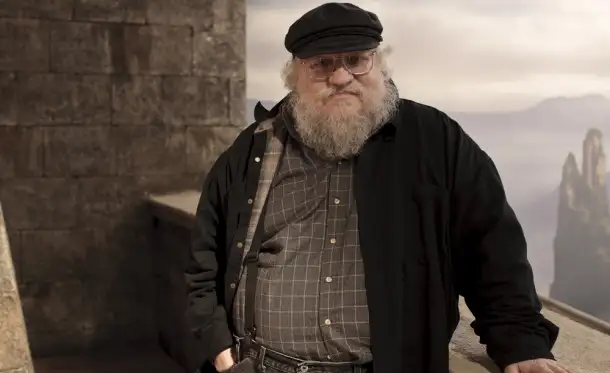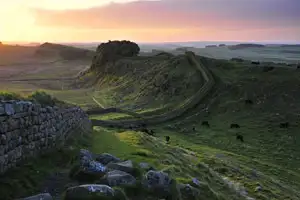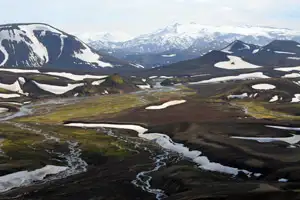
As we approach the season two premiere of the hit HBO series based on his novels, George R.R. Martin talks exclusively with SmarterTravel’s Managing Editor about the real-world places that inspired his fantasy masterpiece, A Song of Ice and Fire. He also reveals the historical model for the central clash in Game of Thrones‘ second season and makes some of his most revealing comments yet about what to expect in the upcoming sixth book, The Winds of Winter.
Editor’s note: This interview contains MAJOR SPOILERS for all five novels. We’ll warn you again right before you get to them.
SmarterTravel: Mr. Martin, it’s a pleasure to speak with you. I’ve been a fan of the Ice and Fire novels since I picked up the first one in 1996.
George R.R. Martin: Oh, well then you’ve been on this long, strange journey with me. (Laughs)
ST: It’s been a fun journey, even though you’ve done some terrible things to my favorite characters over the years! Your books are sometimes described as “fantasy for people who don’t really like fantasy.” I think the first one [A Game of Thrones] in particular reads very much like historical fiction, with magic appearing more or less on the fringes. The supernatural elements become more prominent in the subsequent novels, but the story still retains that historical feel. Do you see fantasy and historical fiction as two sides of the same coin?
GRRM: Yes, at the very least they’re fraternal twins. They have some of the same appeals to the reader. They offer the same pleasures—getting you outside of our society and taking you to either an imaginary fantasy world or a historical epoch where life and the culture and society were different. Both give the reader an opportunity to experience a different sort of world. And so I think the two of them have a lot in common.
ST: Your novels are about political intrigue and civil war and the struggle for power. They have a real-world grittiness that you don’t always find in fantasy literature. For all the comparisons to Tolkien [Martin has been called “The American Tolkien” by Time Magazine], this isn’t a traditional “quest” story—there’s no magic ring to destroy. Was A Song of Ice and Fire a reaction to Tolkien, or more specifically a reaction to the many Tolkien imitators?
GRRM: I think more the latter than the first. I am a huge fan of Tolkien. I read Lord of the Rings when I was in high school. It had a tremendous impact on me and really solidified my love of fantasy. I still reread it every few years. I think all modern fantasy derives from Tolkien.
That being said, of course, like any really successful book, Tolkien has been imitated and imitated and imitated, and I think many of those imitators get it wrong. They take elements from Tolkien and they remove some of the things that make those elements interesting and produce works that to my mind are much inferior. I did not want to do that.
“What lies really north [The Land of Always Winter] … We haven’t explored that yet, but we will in the last two books.”
And also, I read a lot of historical fiction, both the classic writers of historical fiction that I read many decades ago—people like Thomas B. Costain and Frank Yerby and so forth—and some of the more contemporary writers of historical fiction, like Bernard Cornwell, Sharon Kay Penman, and Philippa Gregory.
I wanted to capture these two threads to get some of the magic and the wonder and imagination of fantasy and combine it with some of the grittiness and realism and complexity of historical fiction.
ST: You once described a real-world historical site, Hadrian’s Wall in Northern England, as your inspiration for the Wall in Westeros. How did visiting Hadrian’s Wall lead to the idea for the Night’s Watch?
GRRM: I saw Hadrian’s Wall for the first time in 1981. It was on the occasion of the first time I’d ever been to the U.K., and in fact I think the first time I’d ever left the United States. I was traveling with my friend Lisa Tuttle, who collaborated with me on the novel Windhaven. She had moved to the U.K. and married a British man, and she was showing me around. We were driving around the country and we reached Hadrian’s Wall and it was sunset—it was at the end of the day, so all the tour buses were leaving.
We saw people getting on their buses and going away because it was just about to get dark. We really had the wall to ourselves, which I think was great because it was the fall, and it was kind of a crisp, cold day. The wind was blowing, and I climbed up on the wall and it was really just awesome.
“I’m going to open [The Winds of Winter] with the two big battles that I was building up to, the battle in the ice and the battle of Slaver’s Bay. And then take it from there.”
There was nobody else around, and I stared off to the north as dusk was settling and tried to imagine what it was like to be a Roman stationed on the wall when the wall was an active protection—when it was end of the Roman world, and you didn’t really know what was going to come over those hills or what was going to come out of the woods beyond that. The Romans drew men from all over this immense empire, so you might be someone from Africa or Syria or Egypt who had been assigned to this outpost. What a strange alien world it was for you.
So that was a profound experience that stayed with me. It was over a decade later when I first began Ice and Fire, and I still had that vision and that sense of, “I’d like to write a story about the people guarding the end of the world.”
But, of course, in fantasy you always play with these things. Fantasy is bigger and more colorful, so a mere 10-foot-high wall wasn’t going to do it for me. My wall is 700 feet tall and made of ice. And the things that come out of the north are a good deal more terrifying than Scotsmen or Picts, which is what the Romans had to worry about.
ST: Season two of the HBO series follows A Clash of Kings and takes us to the lands Beyond the Wall. For the production they’re using Iceland as a stand-in. Is the volcanic backcountry there what you imagined when you dreamed up the locations Beyond the Wall—the Haunted Forest and the Frostfangs and the Land of Always Winter?
GRRM: I’ve never actually been to Iceland, which I regret. I wanted to visit the shoot this year, but I was just too busy with other stuff and touring for the new book, so I wasn’t able to make it up there. So I can’t really compare it directly to the actual Iceland. But I’ve seen some pictures of the shoot and it looks incredibly beautiful.
Of course, Iceland is relatively small. Beyond the Wall is considerably larger than Iceland—probably larger than Greenland. And the area closest to my Wall is densely forested, so in that sense it’s more like Canada—Hudson’s Bay or the Canadian forests just north of Michigan. And then as you get further and further north, it changes. You get into tundra and ice fields and it becomes more of an arctic environment. You have plains on one side and a very high range of mountains on the other. Of course, once again this is fantasy, so my mountains are more like the Himalayas. But, you can always play with these things in fantasy.
And what lies really north in my books—we haven’t explored that yet, but we will in the last two books.
ST: You wrote the screenplay for the central set piece in season two, the Battle of the Blackwater. One of my favorite parts of the whole sequence in the books is the trap that Tyrion springs involving a giant chain boom, which reminds me of a similar tactic employed in the real-world battle of Constantinople centuries ago.
GRRM: That certainly was one of the inspirations. Chain booms have been used a number of times in history and in battles for various purposes. So, that was part of the inspiration. Of course, there’s different ways you can use a boom like that. You can raise it early on to close off the harbor—or the river in this case—so ships actually can’t get in. But that wasn’t Tyrion’s plan. (Minor Spoiler) What Tyrion wanted to do was to lure in as much of Stannis’ fleet as he could, and then raise the chain so they couldn’t get back out when he unleashed the wildfire on them.
Wildfire, of course, is my magical version of Greek fire—to go back to the Constantinople reference. And once again, fantasy is bigger, so wildfire is Greek fire times 10. It’s Greek fire but it’s worse than Greek fire, and it’s got a little magical element to it. It’s really nasty stuff, and it burns with green flames, which is a nice pyrotechnical effect. Not sure we’ll get that into the show, but I’ll look forward to seeing it. I hope they do.
ST: After hearing about Dorne in the earlier novels, we finally visit it in the fourth book, A Feast for Crows. It reminds me of Wales, but there are also hints of Spain and the Middle East in there as well. You seem to borrow freely from various cultures.
“I know who’s going to live and who’s going to die. It has all been planned from the beginning.”
GRRM: Yes, I mean you can do one-for-one conversions of the real-world to fantasy, but if you’re going to do one-for-one, you might as well just write straight historical fiction. Why write about a character who’s exactly like Henry VIII? If you want to do that, then just write about Henry VIII.
It makes more sense to take certain interesting elements of Henry VIII and certain interesting elements of Edward IV, and maybe something from here and something from there, and put them together and use your imagination to create your own character—someone who is uniquely himself and not exactly like someone from history. The same is true of the battles and things like that.
History is full of wonderful stories and things that you read in books. My wife is always looking out for history books and saying you can’t make this stuff up. So, it’s a great gold mine for any fantasist to read a lot of history.
ST: Valyria is a place that we never actually see in the books, but its presence is felt throughout. I’ve always associated it with the Roman Empire, but when you describe the Doom of Valyria with the boiling seas and giant tsunamis, it also calls to mind our own legends of Atlantis. Am I on the right track with those comparisons?
GRRM: Yes, and once again I’ve mixed and matched. There are elements of Valyria that are similar to Rome. It was the dominant world power for hundreds of years. Unlike Rome, the dominance was partially based on magic and on dragons, as well as on the strength of their legions. But there is certainly an element to that. Of course, the fall of the Roman Empire was a slow process that took centuries, while Valyria fell overnight. So, in that sense it is more like the Atlantis legends.
A particular real-world influence on the Doom of Valyria was something from the history of New Zealand—the volcanic eruptions that destroyed the Pink and White Terraces. They were a formation of rocks that were considered one of the seven beautiful wonders of the world in the Victorian period. People traveled from all over the world to visit the Pink and White Terraces, which were these beautiful stone terraces where volcanic hot springs water would flow out from the top. It was a series of natural pools at lower levels, and as the water flowed from one pool to another down the side of this mountain, it would cool so the terraces at the top had really hot pools, and at the bottom had warm pools.
They were very scenic, but the whole area was volcanic. One day it just all exploded—the entire area went up, and fortunately it was not a heavily habitable area, so there weren’t a lot of people there. But those two wonders of the world were just gone the next day along with the surrounding lake and a huge sizable area. The last time I was in New Zealand, we were in Rotorua and there was a museum that had a whole room about the Pink and White Terraces and the destruction of them.
Another similar thing was the great explosion of Vesuvius that destroyed Pompeii and Herculaneum. And Krakatoa, yet another gigantic explosion. So, I took all those things together and came up with Valyria—with magic thrown in.
Editor’s note: There are MAJOR SPOILERS for all five Ice and Fire novels beyond this point. Read at your own risk!
ST: One of the dominant themes in the first five books, in fact probably the tagline for the whole series so far, has been that winter is coming. By the end of A Dance with Dragons, winter is no longer coming, it’s finally here. What can you tell us about the book you’re writing now, The Winds of Winter?
GRRM: Well, I’ve posted a preview on my website, so you can read one chapter there, and there will be another chapter in the paperback of A Dance with Dragons when that comes out in the summer. So, you’ll get two free chapters. After that, it’s going to be awhile.
Obviously, I’m going to continue the story. There were a lot of cliffhangers at the end of A Dance with Dragons. Those will be resolved very early. I’m going to open with the two big battles that I was building up to, the battle in the ice and the battle at Meereen—the battle of Slaver’s Bay. And then take it from there.
ST: After what happened to Ned in A Game of Thrones and then Robb in A Storm of Swords, I find myself reading your books with this sort of pleasant pit of dread in my stomach.
GRRM: (Laughs)
ST: And yet, if Ned hadn’t died it becomes an entirely different series. The same with Robb. How early on did you know what was going to happen to those two characters in particular? Or were their deaths something that developed as you went along?
“I write one chapter at a time, one scene at a time, one sentence at a time. Step by step, sooner or later, the journey will get me there.”
GRRM: I knew almost right from the beginning. I know the major beats of the story and who’s going to live and who’s going to die—the ultimate end of all the major characters. There’s a lot of fine detail that I discover along the way in the writing. For some minor characters I may make it up as I’m writing. So, if a major character is going to battle with his six friends, I don’t necessarily know what’s going to happen to all six friends when I sit down to write it. But the major players and the major lives or deaths or life-changing events have all been planned from the beginning.
ST: Along those same lines, a lot of people think you killed Jon at the end of A Dance with Dragons. You do have a history of doing terrible things to the Starks, but my gut says he probably survived. Would you care to comment on that?
GRRM: (Laughs) I will not comment on that.
ST: With Jon effectively out of the picture as Lord Commander, though—even if he lives—I’m not sure I like the Wall’s chances of holding back the Others now that winter has come. Is it safe to assume that we’ll be seeing them move south of the wall in The Winds of Winter?
GRRM: Well, I don’t want to give too much away, but you’re definitely going to see more of the Others in The Winds of Winter.
ST: In A Feast for Crows and A Dance with Dragons, you started using labels like The Queen’s Hand or The Iron Suitor as chapter titles, whereas in the earlier volumes it was always Jon or Ned or Arya, that kind of thing. Is this a way of exploring issues of identity? Particularly with Arya and Sansa and Theon, their entire identities seem to be changing.
GRRM: Yeah, that’s exactly what I’m getting at there. A lot of identities are under assault in these books.
ST: Another theme that emerges—it’s there all along, but it becomes even clearer in the epilogue to A Dance with Dragons—is that the characters who think they’re players in the game of thrones are more often than not the pawns. The real power is in the shadows. Did you intend to explore that idea from the very beginning or has it emerged as the story developed?

Sign up for our free Deal Alert Newsletter to get fresh stories like this delivered to you each day!
GRRM: Well, it depends on what state you’re talking about. When I first began this series back in 1991, I really didn’t know what it was. By the time I was well into A Game of Thrones, though, I knew what the major themes would be, and that is certainly one of them. The nature of power and the uses of power and what people do to get to power—those are some of the major things I’m dealing with.
Varys’ riddle that he poses in A Clash of Kings about the swordsman who gets conflicting demands from the king, the priest, and the wealthy man—whom does he obey? Who actually has the power? I think that’s a central question here.
ST: You’ve spent some time over these last two books resetting the chessboard after the events of the War of the Five Kings. Pieces have been moved around or removed altogether. Danaerys and the Others are both inching closer to the Seven Kingdoms. Winter has come. It feels like we’ve either entered the third act or are on the verge of entering it. Are you beginning to see the light at the end of the tunnel?
GRRM: I certainly hope so. (Laughs) It has been a long journey. Yes, I think I’m starting to see it, but that’s still a very long tunnel. The last book was 1,500 pages in manuscript. I think each of the next two will be at least as long, so that’s 3,000 more pages that I still have to write, and that’s a considerable amount of writing.
I’ve reached a point where I have to stop thinking about things like that, because it’s just too daunting. I write one chapter at a time, one scene at a time, one sentence at a time, and don’t worry about the rest. Step by step, sooner or later, the journey will get me there.
RELATED STORY: ‘Game of Thrones’ in the Real World—See Where the Hit Series Was Filmed
(George R.R. Martin photo by Nick Briggs/HBO)
We hand-pick everything we recommend and select items through testing and reviews. Some products are sent to us free of charge with no incentive to offer a favorable review. We offer our unbiased opinions and do not accept compensation to review products. All items are in stock and prices are accurate at the time of publication. If you buy something through our links, we may earn a commission.
Related
Top Fares From
Today's Top Travel Deals
Brought to you by ShermansTravel
Shop and Save with Country Inns...
Patricia Magaña
 Hotel & Lodging Deals
Hotel & Lodging Deals
$229 -- Chicago: Discounted Rates and...
Francesca Miele
 Hotel & Lodging Deals
$229+
Hotel & Lodging Deals
$229+
$188 -- Honolulu: Save on Oceanview...
Abigail Lamay
 Hotel & Lodging Deals
$188+
Hotel & Lodging Deals
$188+





